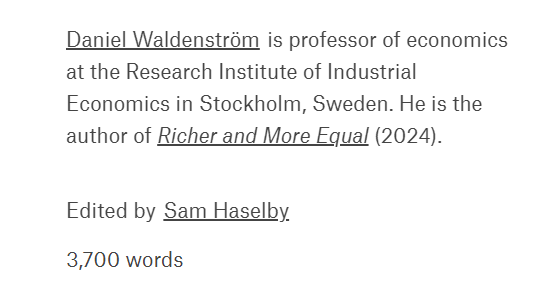Welcome to DU!
The truly grassroots left-of-center political community where regular people, not algorithms, drive the discussions and set the standards.
Join the community:
Create a free account
Support DU (and get rid of ads!):
Become a Star Member
Latest Breaking News
Editorials & Other Articles
General Discussion
The DU Lounge
All Forums
Issue Forums
Culture Forums
Alliance Forums
Region Forums
Support Forums
Help & Search
The great wealth wave

The tide has turned – evidence shows ordinary citizens in the Western world are now richer and more equal than ever before
https://aeon.co/essays/the-surprising-truth-about-wealth-and-inequality-in-the-west


Recent decades have seen private wealth multiply around the Western world, making us richer than ever before. A hasty glance at the soaring number of billionaires – some doubling as international celebrities – prompts the question: are we also living in a time of unparalleled wealth inequality? Influential scholars have argued that indeed we are. Their narrative of a new gilded age paints wealth as an instrument of power and inequality. The 19th-century era with low taxes and minimal market regulation allowed for unchecked capital accumulation and then, in the 20th century, the two world wars and progressive taxation policies diminished the fortunes of the wealthy and reduced wealth gaps. Since 1980, the orthodoxy continues, a wave of market-friendly policies reversed this equalising historical trend, boosting capital values and sending wealth inequality back towards historic highs.
The trouble with the powerful new orthodoxy that tries to explain the history of wealth is that it doesn’t fully square with reality. New research studies, and more careful inspection of the previous historical data, paint a picture where the main catalysts for wealth equalisation are neither the devastations of war nor progressive tax regimes. War and progressive taxation have had influence, but they cannot count as the main forces that led to wealth inequality falling dramatically over the past century. The real influences are instead the expansion from below of asset ownership among everyday citizens, constituted by the rise of homeownership and pension savings. This popular ownership movement was made possible by institutional changes, most important democracy, and followed suit by educational reforms and labour laws, and the technological advancements lifting everyone’s income. As a result, workers became more productive and better paid, which allowed them to get mortgages to purchase their own homes; homeownership rates soared in the West from the middle of the century. As standards of living improved, life spans increased so that people started saving for retirement, accumulating another important popular asset.
Today, the populations of Europe and the United States are substantially richer in terms of real purchasing-power wealth than ever before. We define wealth as the value of all assets, such as homes, bank deposits, stocks and pension funds, less all debts, mainly mortgages. When counting wealth among all adults, data show that its value has increased more than threefold since 1980, and nearly 10 times over the past century. Since much of this wealth growth has occurred in the types of assets that ordinary people hold – homes and pension savings – wealth has also become more equally distributed over time. Wealth inequality has decreased dramatically over the past century and, despite the recent years’ emergence of super-rich entrepreneurs, wealth concentration has remained at its historically low levels in Europe and has increased mainly in the US. Among scholars in economics and economic history, a new narrative is just beginning to emerge, one that accentuates this massive rise of middle-class ownership and its implications for society’s total capital stock and its distribution. Capitalism, it seems, did not result in boundless inequality, even after the liberalisations of the 1980s and corporate growth in the globalised era. The key to progress, measured as a combination of wealth growth and falling or sustained inequality, has been political and institutional change that enabled citizens to become educated, better paid, and to amass wealth through housing and pension savings.
In his book Capital in the Twenty-First Century (2014), Thomas Piketty examined the long-run evolution of capital and wealth inequality since industrialisation in a few Western economies. The book quickly received wide acclaim among both academics and policymakers, and it even became a worldwide bestseller. Piketty’s narrative outlined wealth accumulation and concentration as following a U-shaped pattern over the past century. At the time of the outbreak of the First World War, wealth levels and inequality peaked as a result of an unregulated capitalism, low taxation or democratic influence. During the 20th century, wartime capital destruction and postwar progressive taxes slashed wealth among the rich and equalised ownership. Since 1980, however, goes Piketty’s narrative, neoliberal policies have boosted capital values and wealth inequality towards historic levels. Immediately after publication, Capital generated fierce debate among economists, focused primarily on the book’s theoretical underpinnings. For example, Piketty had sketched a couple of ‘fundamental laws’ of capitalism, defining the economic importance of aggregate wealth. The first law stated that the share of capital income in total income (the other share coming from labour) is a function of how much capital there is in the economy and its rate of return to capital owners.
snip
InfoView thread info, including edit history
TrashPut this thread in your Trash Can (My DU » Trash Can)
BookmarkAdd this thread to your Bookmarks (My DU » Bookmarks)
1 replies, 507 views
ShareGet links to this post and/or share on social media
AlertAlert this post for a rule violation
PowersThere are no powers you can use on this post
EditCannot edit other people's posts
ReplyReply to this post
EditCannot edit other people's posts
Rec (2)
ReplyReply to this post
1 replies
 = new reply since forum marked as read
Highlight:
NoneDon't highlight anything
5 newestHighlight 5 most recent replies
= new reply since forum marked as read
Highlight:
NoneDon't highlight anything
5 newestHighlight 5 most recent replies
The great wealth wave (Original Post)
Celerity
Aug 2024
OP
milestogo
(17,991 posts)1. "more equal"